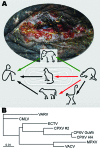Rat-to-elephant-to-human transmission of cowpox virus
- PMID: 18394293
- PMCID: PMC2570944
- DOI: 10.3201/eid1404.070817
Rat-to-elephant-to-human transmission of cowpox virus
Figures

Comment in
-
Cat-to-human orthopoxvirus transmission, northeastern Italy.Emerg Infect Dis. 2009 Mar;15(3):499-500. doi: 10.3201/eid1503.080813. Emerg Infect Dis. 2009. PMID: 19239778 Free PMC article. No abstract available.
References
-
- Kurth A, Nitsche A. Fast and reliable diagnostic methods for the detection of human poxvirus infections. Future Virology. 2007;2:467–79. 10.2217/17460794.2.5.467 - DOI
Publication types
MeSH terms
LinkOut - more resources
Full Text Sources
